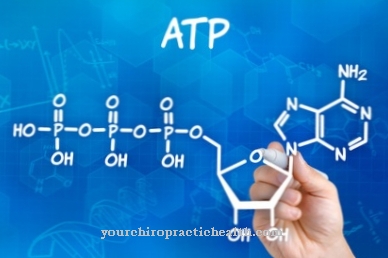Of the Long feedback mechanism is a principle of feedback as it is relevant for the hormonal balance in the human body. The control loop between thyroid hormones and TSH (thyrotropin) is one of the best-known long feedback mechanisms. Disturbances within this control loop occur, among other things, in Graves' disease.
What is the long feedback mechanism?

Feedback mechanisms in the sense of self-regulating feedback play a role in the human body, especially for the hormone system. During self-adjustment, hormones regulate their own secretion. Different types of feedback exist. One of them is the long feedback mechanism, which corresponds to a physiological self-adaptation principle.
The long feedback plays a role, for example, for the thyroid hormones and their effect on the release of the thyrotropin-releasing hormone. In addition, the long feedback mechanism is a basic principle in the central control of the endocrine system. The hypothalamus is at the center of this control. The brain part belongs to the diencephalon and corresponds to the highest regulatory center of all vegetative and endocrine processes.
Essentially, two circuits play a role in the hormonal control processes by the hypothalamus. In addition to the short feedback mechanism, the hypothalamus-adenohypophyseal loop or pituitary loop, this includes the adenohypophyseal or pituitary-end organ loop, which corresponds to a long feedback mechanism.
Function & task
Different regulation principles with feedback mechanisms exist in the human body, especially within the hormonal regulation. Different levels of feedback are involved in this regulation. The hypothalamus is the ultimate center of all hormonal feedback processes.
The brain area contains receptive areas that receive information from the environment, from the central nervous system and from the hormonal body periphery. The information from the body periphery mostly corresponds to changes in the hormone concentration. All of the above information is registered by the receptive fields of the hypothalamus.
The connection between the periphery and the hypothalamus is a long-feedback mechanism. Ultimately, information reaches the pituitary gland from the hypothalamus. This can be done either neurogenic via the tuberohypophyseal tract, or via the portal vasculature via hypophyseal hormones.
The latter is the case with the releasing and inhibiting hormones of the hypothalamus. These hormones are control hormones that have a specific effect on the anterior pituitary gland. Releasing hormones are for example the hormones GHRH, GnRH, CRH and THR. The hypothalamus receives feedback from the pituitary not via a long, but a short feedback mechanism.
The long feedback mechanism between the hypothalamus and the periphery also plays a role for the glandotropic hormones, which themselves represent an important regulatory principle within the endocrine feedback. Since the pituitary gland also receives feedback from the body's periphery through a long feedback mechanism, the gland can use this information to regulate the release of glandotropic hormones and thus influence the secretion of peripheral endocrine organs.
The hypothalamic-pituitary system is therefore fed back multiple times and determines the activity of all glands by using the regulatory principle of the glandotropic hormones. All regulatory levels of the system are controlled in terms of negative feedback. In short, the hormonal balance is organized in control loops that continuously adapt to the body's current hormone requirements. The hypothalamus-pituitary axis is the most important example of this principle.
The long feedback mechanism ultimately plays a role for all hormones and is ultimately also relevant for ovulation, for example. The long feedback effect of estrogens and progesterone is again retrospectively related to the hypothalamus-pituitary system.
The female cycle thus has two important tax components. In addition to the long-loop feedback of estrogens and progesterone on the system between the hypothalamus and pituitary gland, the pulsatile release of the hormones GnRH, LH and FSH plays a role in ovulation.
Illnesses & ailments
The disruption of a single hormone control circuit usually leads to a disruption of the entire hormonal balance and the associated body functions due to the close connections between individual control circuits. An overactive thyroid or an underactive thyroid (hypero- and hypothyroidism) can arise, for example, as a result of a lack or oversupply of TSH and thus indicate a pituitary dysfunction.
The long-feedback mechanism between thyroid hormones and thyrotropin-releasing hormones establishes this connection. TSH-producing tumors can also cause an excess of TRH, which in turn disrupts the thyrotropic control loop.
Effects on the long feedback mechanism between thyroid hormones and TRH can also be seen in diseases such as Graves' disease. The disease leads to an overactive thyroid, which is associated with autoimmunological reactions. The patient's immune system attacks the TSH receptors within the thyroid follicle. IgG-type antibodies bind to the receptors and permanently stimulate them by mimicking the effects of TRH.
Due to the control loops, this results in increased activity of the thyroid gland. An oversupply of thyroid hormones arises. In addition, the gland becomes larger and larger due to growth stimuli. Since the TSH present in the body has no effectiveness due to its inability to bind to receptors, different body functions are ultimately imbalanced.
Due to the increased thyroid hormone concentration, the general TSH concentration decreases via the long feedback mechanism. At the same time, autoantibodies on the pituitary hinder TSH secretion. Although the TSH concentration continues to decrease, the disease is associated with hyperthyroidism.
Cushing's syndrome also leads to disorders of the entire endocrine system. The disease is a disease of the hypothalamic-pituitary-adrenal axis. Anterior pituitary tumors often secrete ACTH, which stimulates high levels of plasma cortisol. The patients suffer from high blood sugar levels, which can be associated with type II diabetes mellitus.
Furthermore, osteoporotic changes and muscle weakness can occur. Trunk obesity with a bull's neck and a full moon face are characteristic signs of Cushing's syndrome.
























.jpg)



